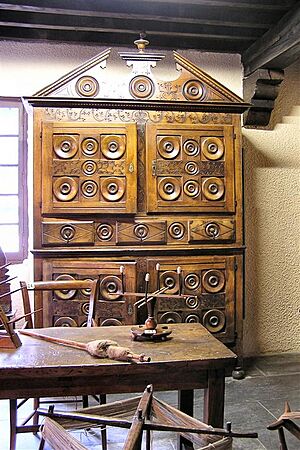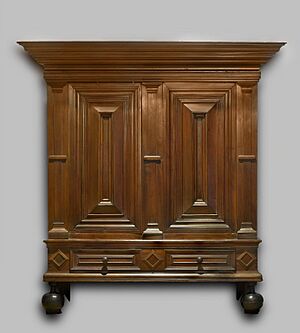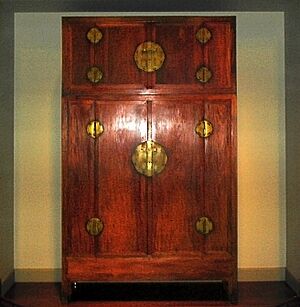Wardrobe facts for kids
A wardrobe is a tall cabinet used for storing clothes. You might also hear it called an armoire or almirah. Long ago, the first wardrobes were just simple chests. Over time, as kings and powerful nobles became wealthier, they needed special places for their fancy clothes. That's when a whole room, called a wardrobe, was created. This room had many small closets and lockers built into its walls.
Later, the idea of a drawer was invented, which was a big step forward! From these early cupboards and lockers, the modern wardrobe slowly developed. Today's wardrobes have spaces for hanging clothes, sliding shelves, and drawers.
Even with all these changes, the main job of a wardrobe has stayed the same: to hold a person's clothes. In the past, like during the time of King Edward I, the word "wardrobe" also meant a place to keep valuable items like gold. Modern wardrobes often have three main parts: two sections on the sides with shelves, and a middle section with hanging rods and drawers. Some even have a special press for clothes in the upper part.
An interesting fact: an armoire is usually a wardrobe that is wider than an adult's arm span, while a regular wardrobe might be a bit smaller.
Contents
What Does "Wardrobe" Mean?
The word wardrobe first appeared in the English language in the early 1300s. It comes from old French words like warderobe or garderobe. In these words, "warder" meant "to keep" or "to guard," and "robe" meant "garment" or "clothing." So, a wardrobe literally means something that "guards clothes."
How Wardrobes Changed Over Time

In the United States, the first movable wardrobes, often made of oak, appeared in the early 1600s. These were actually sent from America to England because England's forests were running out of oak trees. Because of this, these early American wardrobes were sometimes called "oakleys." For about 100 years, many of these large, heavy oak pieces were made, often with beautiful carvings on the front.
Later, walnut wood became more popular for furniture because it was easier to find in America. However, large hanging wardrobes made of walnut were rare. Instead, people often used "clothes presses," which had drawers and sliding trays.
During much of the 1700s, a piece of furniture called a tallboy was very popular for storing clothes.
The Size of Wardrobes
In the 1800s, the wardrobe started to look more like what we see today. It often had a hanging space on each side, a press in the upper middle part, and drawers below. These wardrobes were usually made of mahogany. As beautiful woods like satinwood became more available, many wardrobes were made with detailed and fancy designs.
Designers like Thomas Chippendale used carvings to decorate furniture. Later designers, such as Sheraton and Hepplewhite, created beautiful effects by using different types of wood that were highly polished and contrasted nicely.
A big change happened when the central doors of the wardrobe were extended all the way to the floor. This meant they covered both the drawers and the sliding shelves. These doors often had mirrors on them, which was very useful!
In the United Kingdom, a popular choice for people who could afford it was custom-fitted wardrobes. These are built right into the room, matching its exact size and shape.
What is a Kas?

A Kas (pronounced "kaz") is a very large cupboard or wardrobe. It came from the Netherlands and was popular there and in America during the 1600s and 1700s. Kases were similar to armoires and had shelves and drawers inside. People used them to store linen, clothing, and other valuable items, and they could be locked with a key.
Kases were seen as important symbols of wealth and were often passed down through families in the Netherlands. They were also imported as luxury goods to the American colonies. Because they were so special, kases were often made from high-quality woods like cherry, rosewood, and ebony. They were often decorated with panels, carvings, or paintings.
See also
 In Spanish: Armario para niños
In Spanish: Armario para niños


